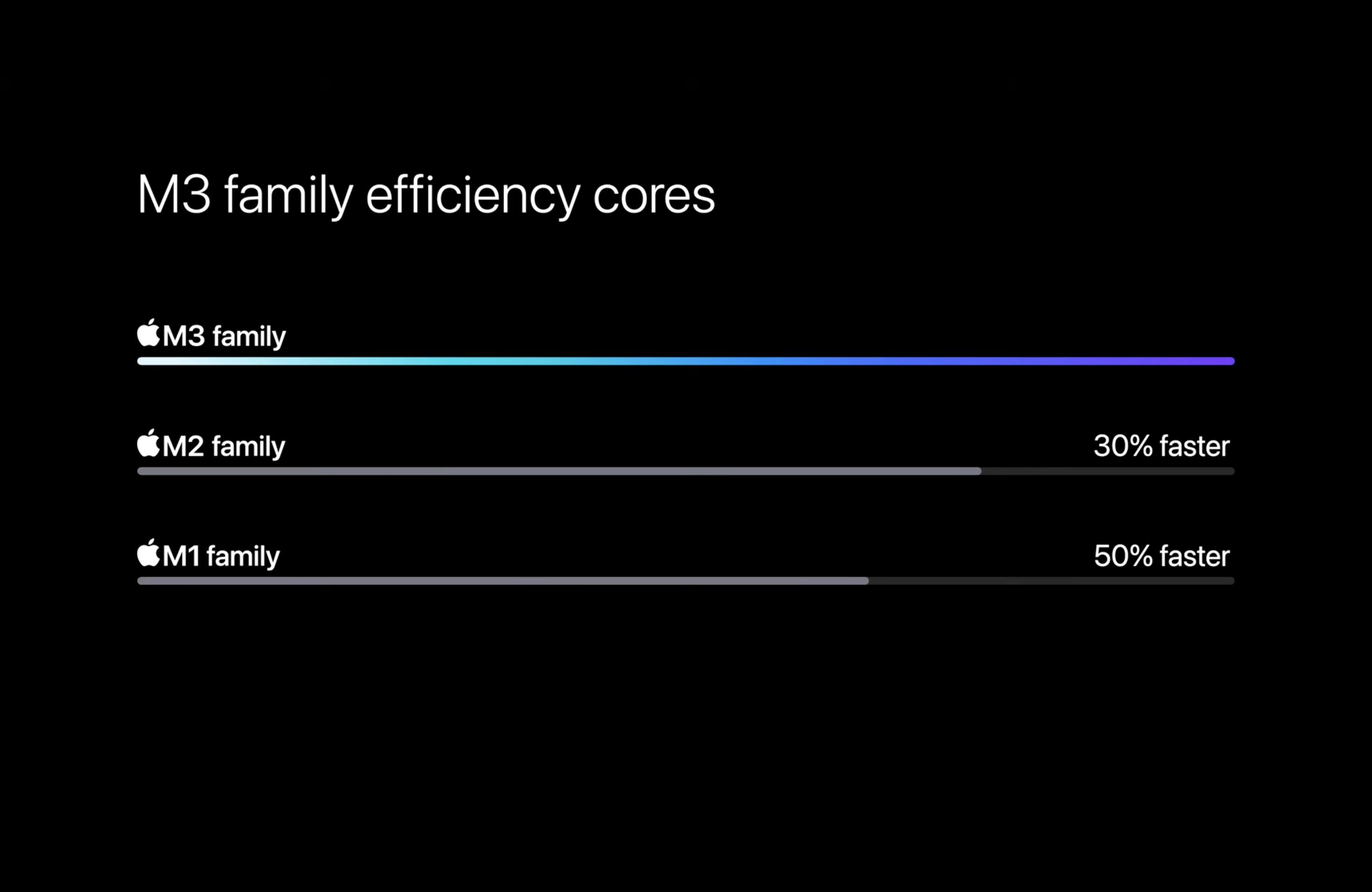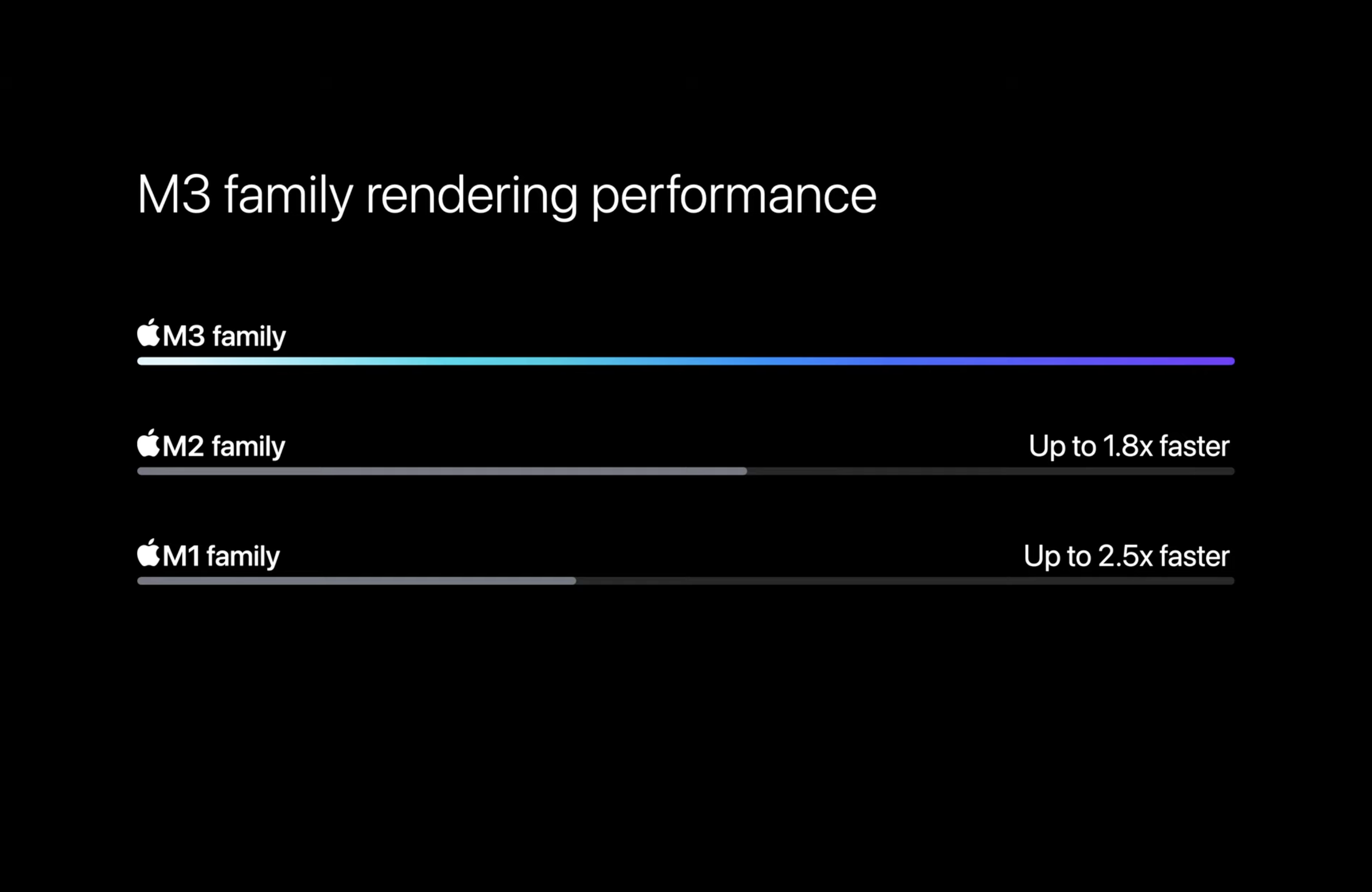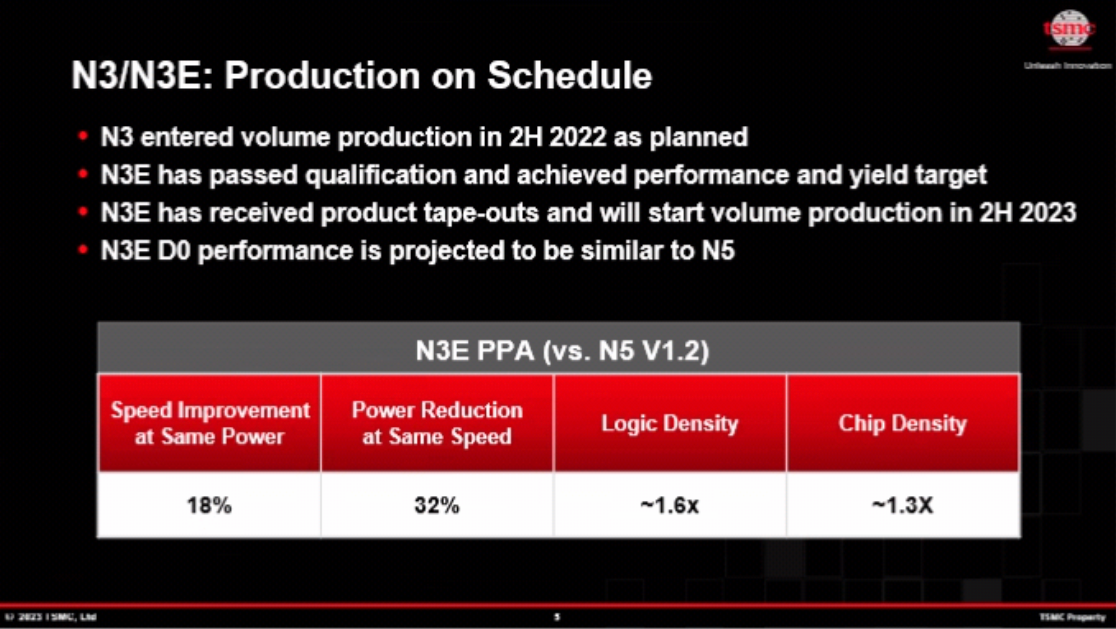Apple held a random Mac event out of nowhere on Halloween Eve called “Scary Fast” and launched 3 new chips and new MacBooks to house them. It was once again a pre-recorded infomercial, albeit smaller, this time at 30 mins instead of the regular 90.
It is the first time that Apple launched all three M3 family chips at the same time instead of releasing the bigger chips later. The M3, M3 Pro, and M3 Max are based on TSMC’s 3-nanometer process, the same one that went into the A17 Pro chip released a few months ago.

M3 Family – a worthy year-on-year successor?
Let’s start with what’s new this time. The M3 family is a mild upgrade over the M2 and M1 families, with the biggest boosts coming in the GPU department.

The performance cores in the M3 are around 15% faster than M2 and 30% faster than M1. Meanwhile, the efficiency cores are 30% and 50% faster than the M2 and M1 chips, respectively.

There is a slight change in the CPU core configuration, with the base M3 having 4 P and E cores each, the M3 Pro having up to 6 P and E cores, and the M3 Mac having up to 12 performance and 4 efficiency cores.
While the M3 and the M3 Max are clear upgrades, the M3 Pro has actually lost a couple of performance cores (the M2 Pro comes with 8 performance and 4 efficiency cores). In addition, the Pro comes with a slower memory bus at approximately 150 GB/s compared to the 200 Gb/s bus on the M2.
The M3 and M3 Max retain their 100 GB/s and 400 GB/s memory bus controllers. There is also a version of the M3 Max with a 30-core GPU that suffers the same fate as the M3 Pro, cutting over a quarter of its memory bus, maxing out at 300 GB/s.
M3 Pro seems like a downgrade (and the weird configuration choices) due to availability issues at TSMC, which I will dive a bit deeper into in a later section.
GPU Upgrades
The M3 Family is based on an entirely new GPU architecture, offering new Apple-first, industry-first features.
The rendering times from the M3 chips are up to 1.8 times faster than the M2 and up to 2.5 times faster than the M1 family. The base M3 comes with 10 GPU cores, the M3 Pro with up to 18 GPU cores, and the M3 Max with up to 40 cores.

For the first time, the MacBook Pros come with hardware-accelerated mesh shading and ray tracing, which were also introduced with the A17 Pro chip. This is an upgrade for gaming on Macs, allowing for more realistic shadows and reflections in games and better efficiency in geometric processing.
The M3 chips also introduce Dynamic Caching, which is Apple’s way of calling Just In Time (JIT) allocation. Basically, the unified memory allocates itself to hardware in real-time, depending on what the application in use calls for, instead of depending on the software to allocate bandwidth memory bandwidth. JIT allocation has been a thing before, but it has never really been popular in consumer tech.
The New MacBook Pros
These chips are housed in new MacBook Pros, which are essentially the same chassis as the M2 MacBook Pros except one.
The 13” touch bar MacBook Pro is now gone from the lineup. The 14” and the 16” MacBook Pros get all the new chips, meaning the 14” model now gets the M3 and is the base model in the Pro lineup.
With M3s, the MacBook Pros can be configured with up to 128 GB of unified memory, which Apple says is perfect for “extreme users,” i.e., pros using multiple plugins and services for their daily tasks.
The Liquid Retina XDR display also stays the same, going up to 1600 nits of peak brightness.
Well, almost.
The 120 Hz screen now pushes 600 nits for SDR content compared to the 500 nits, but this bump seems to be done in software that boosts the luminance without losing accuracy.
What also stays the same is the display output capabilities from the earlier iterations. With the base M3, you can output to one external 6K display at 60Hz; with the M3 Pro, you can go up to two external displays and up to four with the M3 Max.

Apple also released a new Space Black color for the M3 Pro and M3 Max, made with reinforced aluminum made with a special anodization process. This one should be more fingerprint-resistant than the Midnight Black, but we need to wait for the actual devices to see how their claims hold up.
What is with the weird configuration choices?
When you go to the configuration page, you will find that you cannot really configure your new MacBook Pros as you wish. Each processor is only available with select memory configurations, with the rest grayed out.

The M3 chips are based on TSMC’s 3-nanometer N3B process, which is also the base of the A17 Pro in the iPhone 15 Pros.
Why is that interesting?
TSMC’s 3nm process will likely contain 4 process technologies, i.e., N3B, N3E, N3P, and N3X. The base N3 (N3B) has been shipping since late 2022, and the N3E was supposed to be available in 23H2.

N3E is a more refined process over the vanilla N3, offering a wider process window and better yields with lower costs. Moreover, N3E will serve as the base of the next process, the N3P, which will have an even higher transistor density, already making it the most popular 3nm process (source).
But why is this important?
Everything up until now suggests that N3B has not been the success it was supposed to be with lousy yields and high costs. TSMC even fronted the cost of defective chips to keep Apple’s business (source), as almost everyone other than Apple simply decided to skip the vanilla N3 for N3E. Even Apple had to reduce the original order size due to TSMC’s inability to meet targets.
Just two weeks before the launch of M3 chips, TSMC announced that mass production of N3E would begin in Q4 of 2023. The new M3s are shipping next week, meaning they are all but based on the lower yield, more expensive base N3 process and not the N3E.
While that is not a problem in itself – the chips are better than the old N5 – it does explain the goofy configuration choices available on the website.
Who should upgrade to the M3 MacBook Pros?
The M3 Family MacBook Pros are excellent devices in themselves. If you are looking to switch to the Apple ecosystem or are still on the Intel-based Macs, you can upgrade with your eyes closed.
I am on an M2 device, and the GPU upgrades do not fit into my workflow, so I will be skipping the upgrade. When the M4 comes around on the next 3nm process, I will wait for that before making the switch. However, if the upgrades are something you need right now, check if the configuration you need is available and get your device.
Leave your thoughts about the device and let us know if you will be making the switch.
